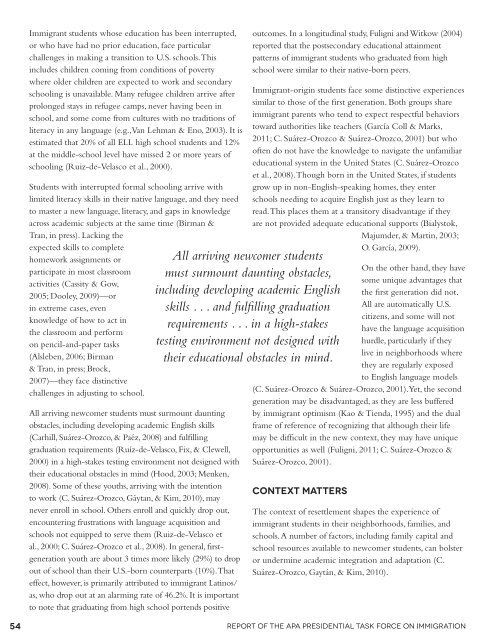Crossroads: The Psychology of Immigration in the New Century
Crossroads: The Psychology of Immigration in the New Century
Crossroads: The Psychology of Immigration in the New Century
Create successful ePaper yourself
Turn your PDF publications into a flip-book with our unique Google optimized e-Paper software.
Immigrant students whose education has been <strong>in</strong>terrupted,<br />
or who have had no prior education, face particular<br />
challenges <strong>in</strong> mak<strong>in</strong>g a transition to U.S. schools. This<br />
<strong>in</strong>cludes children com<strong>in</strong>g from conditions <strong>of</strong> poverty<br />
where older children are expected to work and secondary<br />
school<strong>in</strong>g is unavailable. Many refugee children arrive after<br />
prolonged stays <strong>in</strong> refugee camps, never hav<strong>in</strong>g been <strong>in</strong><br />
school, and some come from cultures with no traditions <strong>of</strong><br />
literacy <strong>in</strong> any language (e.g., Van Lehman & Eno, 2003). It is<br />
estimated that 20% <strong>of</strong> all ELL high school students and 12%<br />
at <strong>the</strong> middle-school level have missed 2 or more years <strong>of</strong><br />
school<strong>in</strong>g (Ruiz-de-Velasco et al., 2000).<br />
Students with <strong>in</strong>terrupted formal school<strong>in</strong>g arrive with<br />
limited literacy skills <strong>in</strong> <strong>the</strong>ir native language, and <strong>the</strong>y need<br />
to master a new language, literacy, and gaps <strong>in</strong> knowledge<br />
across academic subjects at <strong>the</strong> same time (Birman &<br />
Tran, <strong>in</strong> press). Lack<strong>in</strong>g <strong>the</strong><br />
expected skills to complete<br />
homework assignments or<br />
participate <strong>in</strong> most classroom<br />
activities (Cassity & Gow,<br />
2005; Dooley, 2009)—or<br />
<strong>in</strong> extreme cases, even<br />
knowledge <strong>of</strong> how to act <strong>in</strong><br />
<strong>the</strong> classroom and perform<br />
on pencil-and-paper tasks<br />
(Alsleben, 2006; Birman<br />
& Tran, <strong>in</strong> press; Brock,<br />
2007)—<strong>the</strong>y face dist<strong>in</strong>ctive<br />
challenges <strong>in</strong> adjust<strong>in</strong>g to school.<br />
All arriv<strong>in</strong>g newcomer students must surmount daunt<strong>in</strong>g<br />
obstacles, <strong>in</strong>clud<strong>in</strong>g develop<strong>in</strong>g academic English skills<br />
(Carhill, Suárez-Orozco, & Paéz, 2008) and fulfill<strong>in</strong>g<br />
graduation requirements (Ruíz-de-Velasco, Fix, & Clewell,<br />
2000) <strong>in</strong> a high-stakes test<strong>in</strong>g environment not designed with<br />
<strong>the</strong>ir educational obstacles <strong>in</strong> m<strong>in</strong>d (Hood, 2003; Menken,<br />
2008). Some <strong>of</strong> <strong>the</strong>se youths, arriv<strong>in</strong>g with <strong>the</strong> <strong>in</strong>tention<br />
to work (C. Suárez-Orozco, Gáytan, & Kim, 2010), may<br />
never enroll <strong>in</strong> school. O<strong>the</strong>rs enroll and quickly drop out,<br />
encounter<strong>in</strong>g frustrations with language acquisition and<br />
schools not equipped to serve <strong>the</strong>m (Ruiz-de-Velasco et<br />
al., 2000; C. Suárez-Orozco et al., 2008). In general, firstgeneration<br />
youth are about 3 times more likely (29%) to drop<br />
out <strong>of</strong> school than <strong>the</strong>ir U.S.-born counterparts (10%). That<br />
effect, however, is primarily attributed to immigrant Lat<strong>in</strong>os/<br />
as, who drop out at an alarm<strong>in</strong>g rate <strong>of</strong> 46.2%. It is important<br />
to note that graduat<strong>in</strong>g from high school portends positive<br />
All arriv<strong>in</strong>g newcomer students<br />
must surmount daunt<strong>in</strong>g obstacles,<br />
<strong>in</strong>clud<strong>in</strong>g develop<strong>in</strong>g academic English<br />
skills . . . and fulfill<strong>in</strong>g graduation<br />
requirements . . . <strong>in</strong> a high-stakes<br />
test<strong>in</strong>g environment not designed with<br />
<strong>the</strong>ir educational obstacles <strong>in</strong> m<strong>in</strong>d.<br />
outcomes. In a longitud<strong>in</strong>al study, Fuligni and Witkow (2004)<br />
reported that <strong>the</strong> postsecondary educational atta<strong>in</strong>ment<br />
patterns <strong>of</strong> immigrant students who graduated from high<br />
school were similar to <strong>the</strong>ir native-born peers.<br />
Immigrant-orig<strong>in</strong> students face some dist<strong>in</strong>ctive experiences<br />
similar to those <strong>of</strong> <strong>the</strong> first generation. Both groups share<br />
immigrant parents who tend to expect respectful behaviors<br />
toward authorities like teachers (García Coll & Marks,<br />
2011; C. Suárez-Orozco & Suárez-Orozco, 2001) but who<br />
<strong>of</strong>ten do not have <strong>the</strong> knowledge to navigate <strong>the</strong> unfamiliar<br />
educational system <strong>in</strong> <strong>the</strong> United States (C. Suárez-Orozco<br />
et al., 2008). Though born <strong>in</strong> <strong>the</strong> United States, if students<br />
grow up <strong>in</strong> non-English-speak<strong>in</strong>g homes, <strong>the</strong>y enter<br />
schools need<strong>in</strong>g to acquire English just as <strong>the</strong>y learn to<br />
read. This places <strong>the</strong>m at a transitory disadvantage if <strong>the</strong>y<br />
are not provided adequate educational supports (Bialystok,<br />
Majumder, & Mart<strong>in</strong>, 2003;<br />
O. García, 2009).<br />
On <strong>the</strong> o<strong>the</strong>r hand, <strong>the</strong>y have<br />
some unique advantages that<br />
<strong>the</strong> first generation did not.<br />
All are automatically U.S.<br />
citizens, and some will not<br />
have <strong>the</strong> language acquisition<br />
hurdle, particularly if <strong>the</strong>y<br />
live <strong>in</strong> neighborhoods where<br />
<strong>the</strong>y are regularly exposed<br />
to English language models<br />
(C. Suárez-Orozco & Suárez-Orozco, 2001). Yet, <strong>the</strong> second<br />
generation may be disadvantaged, as <strong>the</strong>y are less buffered<br />
by immigrant optimism (Kao & Tienda, 1995) and <strong>the</strong> dual<br />
frame <strong>of</strong> reference <strong>of</strong> recogniz<strong>in</strong>g that although <strong>the</strong>ir life<br />
may be difficult <strong>in</strong> <strong>the</strong> new context, <strong>the</strong>y may have unique<br />
opportunities as well (Fuligni, 2011; C. Suárez-Orozco &<br />
Suárez-Orozco, 2001).<br />
Context Matters<br />
<strong>The</strong> context <strong>of</strong> resettlement shapes <strong>the</strong> experience <strong>of</strong><br />
immigrant students <strong>in</strong> <strong>the</strong>ir neighborhoods, families, and<br />
schools. A number <strong>of</strong> factors, <strong>in</strong>clud<strong>in</strong>g family capital and<br />
school resources available to newcomer students, can bolster<br />
or underm<strong>in</strong>e academic <strong>in</strong>tegration and adaptation (C.<br />
Suárez-Orozco, Gaytán, & Kim, 2010).<br />
54 Report <strong>of</strong> <strong>the</strong> APA Presidential Task Force on <strong>Immigration</strong>
















